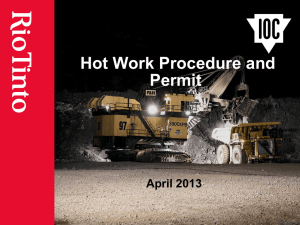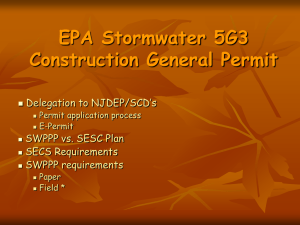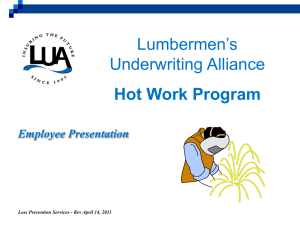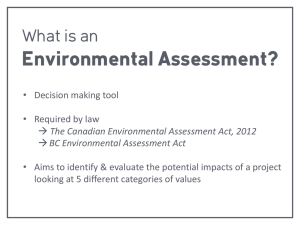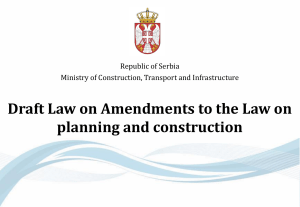2015 Update to the Ontario Building Code
advertisement
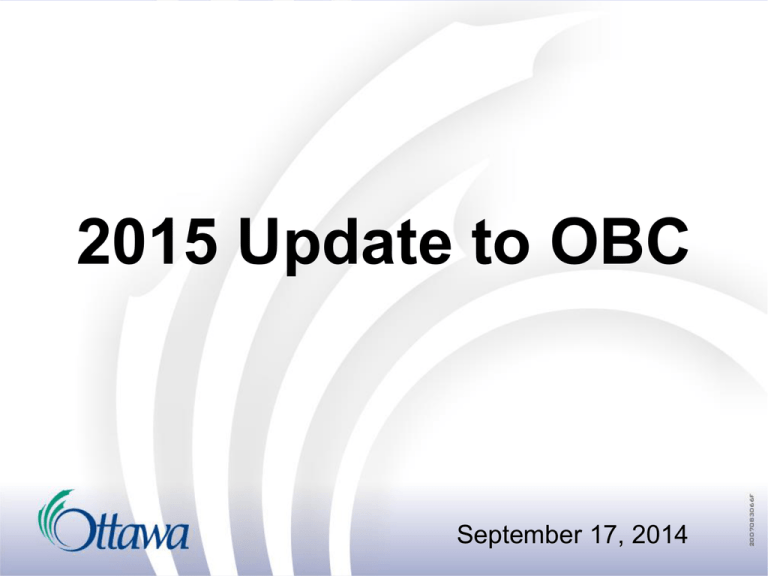
2015 Update to OBC September 17, 2014 2014 Update package Minor changes to the code: occupancy to occupancy Regulation to regulation Missing words Updated fees for BMEC submissions 2 Building Code Act Issuance of permits 8. (2) The chief building official shall issue a permit referred to in subsection (1) unless, (b.1) the Architects Act or the Professional Engineers Act requires that the proposed construction of the building be designed by an architect or a professional engineer or a combination of both and the proposed construction is not so designed; 3 Voice Communication Housekeeping change to 3.2.4.23.(10) (10) The voice communication system required by Sentence (7) shall meet the silencing and transmission requirements of Sentences (3) to (5). Previously referenced (6) 4 January 1, 2015 Multiple changes to the code with respect to increasing Accessibility I have included only those that impact CFAA issues 5 Referenced Documents NFPA 72-2013 “National Fire Alarm and Signaling Code” added Referenced to Smoke Alarms in 3.2.4.22.(13) and 9.10.19.1. 6 3.2.4.19.(4) Alert and Alarm Signals Two new additions: (4) … visual signal devices shall be installed in addition to audible signal devices, (e) in a washroom for public use described in Sentence 3.8.2.3.(2), (3), (4) or (6), and (f) in the living space in a suite of residential occupancy in a Group C major occupancy apartment building. 7 3.2.4.22.(13) Smoke Alarms New sentence: 13) Smoke alarms described in Sentence (1) shall have a visual signaling component conforming to the requirements in 18.5.3. (Light, Color and Pulse Characteristics) of NFPA 72, “National Fire Alarm and Signaling Code”. 8 3.8.1.5 Controls Manual pull stations in a Barrier-Free path of travel: Accessible by a person in a wheelchair Operate with a closed fist, max 22.2.N force Mounted a 1200 mm above finished floor Note: Thermostats at 1200 mm and other building controls min 900 mm / max 1100mm 9 9.10.19.1 Smoke Alarms New sentence: 2) Smoke alarms described in Sentence (1) shall have a visual signaling component conforming to the requirements in 18.5.3. (Light, Color and Pulse Characteristics) of NFPA 72, “National Fire Alarm and Signaling Code”. 10 Other Accessibility Changes These items may not directly impact F/A systems For information to clarify why you may see design changes 11 Areas Requiring Access 3.8.2.1. Old: • Entrance storey and all floor areas accessed by an elevator, escalator or lift New: • Entrance storey and all floor areas accessed by an elevator, escalator or lift • All office and residential buildings exceeding 3 storeys OR 600 m2 12 Rooftop Amenity Space External rooftop spaces are common amenity areas on new buildings. These must be made accessible. Rooftop spaces for building services are not included. 13 Residential Suites 3.8.2.1. Old • 10% of units to BF requirements • Can be located anywhere in the building New • 15% of units to BF requirements • Proportioned to 1, 2 and 3+ bedrooms • Distributed among storeys 14 Washrooms 3.8.2.3. Old • BF washrooms OR stalls, only 1/floor New • # BF washrooms based on height of building • # BF stalls as a ration of the # WC 15 Hotels 3.8.2.4. 10% of suites to be BF (existing) Controls and safety devices in the suite to 3.8.1.5. (new) Suite entrances doors to BF suites have power door operators (new) 16 Hotels 3.8.2.4. If the hotel has a generator for emergency power • Minimum 1 receptacle to be supplied with emergency power • The receptacle to be signed EMERGENCY POWER OUTLET 17 Doors 3.8.3.3. Principle entrance doors to buildings to have power door operators. If a Vestibule occurs, both doors require power door operators Exception for Detention occupancies and Industrial Occupancies (Previously more exceptions) 18 Doors 3.8.3.3. Power door operators required on: • BF washrooms • Assembly occupancies within residential buildings Where proximity scanners are used, they must detect a person in a wheelchair 19 3.8.3.12 Universal Washroom An emergency call system with audible and visual signal devices inside the Barrier-Free washroom Must be different from the building fire alarm (both visual and audible) 20 - 21 - 22 Sliding Door 23 Doors in series 24 Washroom Stalls 25 Ambulatory Washroom 26 Universal Washroom 27 Grab Bars 28 Accessible Urinal 29 Fire Code Changes Amendments to the Fire Code Retrofit requirements will also have impact on your work. 30 Permit Requirements Fire Alarm Systems 31 Scope of Work Maintenance – No Permit Required Repair – Permit Required Upgrade – Permit Required Replace – Permit Required Emergency Repairs – Permit required as above 32 Maintenance – No Permit To keep the system functioning to original design and installation standards Replacement of defective components with compatible components Defective control panels may be replaced only if the exact replacement panel is available 33 Repair - Permit Substantial replacement of equipment that will improve the fire alarm performance Replacement of older panels that are no longer available New panels to accommodate newer technology 34 Repair - Permit Panel from a different manufacturer New components that incorporate newer technology Installation to CAN/ULC-S524 and Verification to CAN/ULC-S537 Professional involvement is necessary where required by the OBC or PEO 35 Upgrade - Permit Involves changes to the design of the original system Upgrading may be voluntary by the owner Upgrading may be as a result of a Fire Code order May include the addition of new devices, components, panels, zones 36 Upgrade - Permit May include upgrades necessary for compliance with barrier-free accessibility requirements Installation to CAN/ULC-S524 and Verification to CAN/ULC-S537 Professional involvement is necessary where required by the OBC or PEO 37 Replace - Permit The complete replacement of a fire alarm system Replacement of a substantial portion of the system Replacement may be voluntary, as a result of a building renovation program or as a result of a Fire Code order 38 Replace - Permit Installation to CAN/ULC-S524 and Verification to CAN/ULC-S537 Professional involvement is necessary where required by the OBC or PEO 39 Emergency Repairs Fire alarm systems in occupied buildings that cease to be operational must be repaired immediately. If the scope of work falls under Repair, Upgrade or Replace from above, a permit should be obtained and after the work is completed. 40 Emergency Repairs Installation to CAN/ULC-S524 and Verification to CAN/ULC-S537 Professional involvement is necessary where required by the OBC or PEO Note: Is notification to the Fire Department required or recommended? 41


